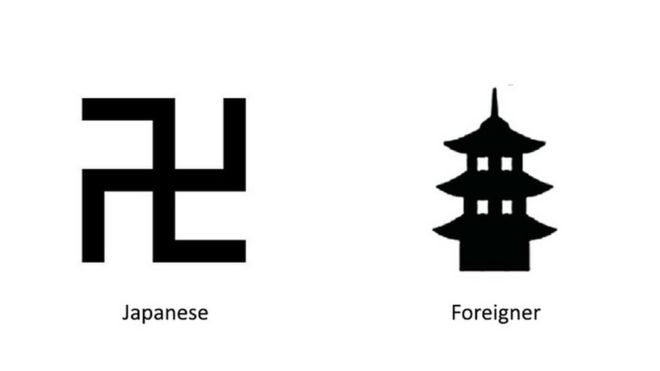Symbols and their Historic and Practical Contexts
Important changes for understanding.
Hypothetically, you've been placed on the lucky team of Graphic Designers who are charged with designing maps for the 2020 Olympics that is being held in Tokyo. Sentimental or Practical?
A friend of mine shared this link to a BBC article and comment with me today:
"I think they should leave them the way they are."And this got me thinking...
A small part of me agrees with my friend. I suspect it's the part of me that turned Japanese, out of necessity, in order to empathetically understand and function in Japan. (I consider myself lucky and honored to have the experience of living and working in Japan.)
Preface
IF you arent familiar with this issue and haven't read the article, it basically talks about map/cultural symbols used to aid visitors in navigating areas around Tokyo for the Olympic games. I'll stick to the swastika in this post. To also be clear thre are only plans (that I know of) to change the tourist symbols and probably only in areas related to the Olympic games.Culture is perpetually evolving. And to some degree, so are symbols.
Sentimental Perspective
From the perspective of a historian or Buddhist the swastika shouldn't have to change to be politically correct; that is to say that, just because some people may not know the history of the swastika means that the symbol should not be replaced for them. History happens in a specific way but there are many perspectives included which are created by the people involved and its our responsibility to understand history from the contextually relevant perspectives.Symbols are reused and variations are created over time, but any one variation should not be allowed to taint and augment our modern perception, most of us who think about this have probably gotten to this point where the symbol should be stronger and last longer than the taint of misinformation and how modern society has come to understand a particular symbol. All that said, I believe its important to educate people (in a contextually appropriate way) to know the difference between the ancient use of this symbol and the modern altered version as well as it's limited uses.
Practical Perspective
How much effort is needed to understand a symbol? Controversy and abstract meanings are avoided as much as possible. Get to the core of the meaning is the main job of a symbol. Keep it simple.For example, a tourist is visiting Tokyo for the first time and finds themselves at a public map outside a subway station, is the context here and the relevant perspective is that they have to interpret said map and understand what they are looking at and where it is in relation to their location.
That same small part of me that agrees that the symbol should be unaltered, is also confused by double standards. They only plan to change the tourist maps, presumably that they will provide visitors at information desks/kiosks/police boxes/etc.. Natives get one version, non-natives get a altered version.
A decision is pending
"The proposed new symbols would be, for now, used only in maps for foreign tourists"The end result of my thoughts which lead me to say that symbols should be redesigned from time to time, but religious symbols are not the same as a hospital sign. The strictly religious symbols should weigh more than the others like a hospital sign or whatever. If any changes are to be made they should be made across the board, from now on, on new maps/signs.
From a designer's point of view, on why its a such a heavy issue... is that a symbol, as we know is the foundation of purity and should be immediately obvious to all, in contextual proximity. We (as a society) can no longer plead ignorance and should have global standards in terms of international relations. So dont change the religious symbol (minor alterations/revisions are cool though, of course.) but practical things like police/emergency/stuff should be standardized every so often.
In a perfect world every country would share the same or similar symbols for important things if nothing but out of simple respect.
Comments
Post a Comment